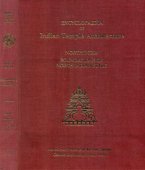Calukya, Cālukya: 7 definitions
Introduction:
Calukya means something in Hinduism, Sanskrit, the history of ancient India. If you want to know the exact meaning, history, etymology or English translation of this term then check out the descriptions on this page. Add your comment or reference to a book if you want to contribute to this summary article.
Alternative spellings of this word include Chalukya.
India history and geography
Source: Wikipedia: India HistoryThe Chalukya dynasty was an Indian royal dynasty that ruled large parts of southern and central India between the 6th and the 12th centuries. During this period, they ruled as three related yet individual dynasties.
1) 6th-8th century: the Badami Chalukyas, ruled from Vatapi (modern Badami) .
2) 7th-12th century: the Eastern Chalukyas became an independent kingdom in the eastern Deccan. They ruled from Vengi.
3) 10th-12th century: the Western Chalukyas, in the late 10th century, ruled from Kalyani (modern Basavakalyan).
A theory that they were descendants of a 2nd-century chieftain called Kandachaliki Remmanaka, a feudatory of the Andhra Ikshvaku (from an Ikshvaku inscription of the 2nd century) was put forward.
Court poets of the Western Chalukya dynasty of Kalyani narrate:
“Once when Brahma, the creator, was engaged in the performance of the sandhya (twilight) rituals, Indra approached and beseeched him to create a hero who could put to an end the increasing evil on earth. On being thus requested, Brahma looked steadily into the Chuluka-jala (the water of oblation in his palm) and out sprang thence a great warrior, the progenitor of the Chalukyas”.
The Chalukyas claimed to have been nursed by the Sapta Matrikas (“seven divine mothers”) and were worshippers of many gods including Siva, Vishnu, Chamundi, Surya, Kubera, Parvati, Vinayaka and Kartikeya.
Source: Eastern Calukyas: Administration and CultureCālukya (चालुक्य).—The Eastern Cālukyas ruled the kingdom of Veṅgi, which comprised Andhra and part of Kaliṅga, for more than five hundred years. During this period they developed there a civilisation of a high order which was their own. In later time they also held sway over the Cola country. But the civilisation of the Cola country of this age is peculiar to the Colas and not tothe Eastern Cālukyas.
Source: Shodhganga: Kakati Ganapatideva and his timesCālukya is one of the ancient dynasties from India (Āndhradeśa or Andhra Pradesh), conquered and subjugated by Gaṇapatideva (r. 1199-1262 A.D.) who let them rule their territory as an independent māṇḍalika.—A branch of the Cālukyas exercised sway over a portion of Godavari district from Niḍadavole and Taḍikalapūḍi. Like the earlier Cālukyas of Veṅgī they also claimed to have been the Kṣatriyas of lunar race, Mānavyasa-gotra and of the lineage of Hāriti. They acknowledged the suzerainty of the Cālukyas of Piṭhāpuraram and later of the Kāktīyas.
Source: Shodhganga: Elements of Art and Architecture in the Trtiyakhanda of the Visnudharmottarapurana (history)Calukya refers to a certain period in the history of Indian Art.—The chronological order of the development of Indian Art as stated in The Heritage of Indian Art is as follows—[...] 11. Cālukya dynasty belongs to 550-642 A.D. The Cālukya dynasty has also a bright value in the field of Art and Architecture. The Temples of Aihole, Badami and Pattadakal, excavated Buddhist, Jaina and Hindu cave temples at Ellora are the greatest monuments of Cālukya dynasty.

The history of India traces the identification of countries, villages, towns and other regions of India, as well as mythology, zoology, royal dynasties, rulers, tribes, local festivities and traditions and regional languages. Ancient India enjoyed religious freedom and encourages the path of Dharma, a concept common to Buddhism, Hinduism, and Jainism.
Languages of India and abroad
Sanskrit dictionary
Source: Cologne Digital Sanskrit Dictionaries: Monier-Williams Sanskrit-English DictionaryCālukya (चालुक्य):—[from cālikya] m. Name of a dynasty, [Inscriptions]
[Sanskrit to German]
Sanskrit, also spelled संस्कृतम् (saṃskṛtam), is an ancient language of India commonly seen as the grandmother of the Indo-European language family (even English!). Closely allied with Prakrit and Pali, Sanskrit is more exhaustive in both grammar and terms and has the most extensive collection of literature in the world, greatly surpassing its sister-languages Greek and Latin.
See also (Relevant definitions)
Starts with: Calukyabhimapura, Calukyavikramakala.
Full-text (+75): Badami, Natavadi, Vengi, Calukyavikramakala, Calikya, Vikramavarsha, Calukkuventan, Puri, Jaggadeva, Attili, Calukyabhimapura, Kollipaka, Sarashipuri, Prithivipallavapattana, Nadndlapura, Bhulokamalla someshvara, Vinayaditya, Madapalla, Virajapuri, Niravadyapura.
Relevant text
Search found 14 books and stories containing Calukya, Cālukya; (plurals include: Calukyas, Cālukyas). You can also click to the full overview containing English textual excerpts. Below are direct links for the most relevant articles:
Impact of Vedic Culture on Society (by Kaushik Acharya)
Mingling of Cultures (N): The Cālukyas < [Chapter 4]
6. Sacrifices With Political Significance < [Chapter 2]
4. Religious Aspect of Dāna < [Chapter 2]
Vastu-shastra (5): Temple Architecture (by D. N. Shukla)
Trishashti Shalaka Purusha Caritra (by Helen M. Johnson)
Matangalila and Hastyayurveda (study) (by Chandrima Das)
Appendix III: Elephant on other Coins
Appendix I: List of Inscriptions
Metaphors related to Elephants < [Chapter 4]
Vishnudharmottara Purana (Art and Architecture) (by Bhagyashree Sarma)
3. A General Note on Art < [Chapter 1 - Introduction]
4. The Viṣṇudharmottara-purāṇa and Temple Architecture of India < [Chapter 6 - Modern Relevance of Different Art Forms and Architecture]
Expiatory Rites in Keralite Tantra (by T. S. Syamkumar)
1.8 (a). Expiatory Rites in other Saiva Treatises < [Chapter 2 - Expiatory Rites in Āgamic Literature]
Related products
